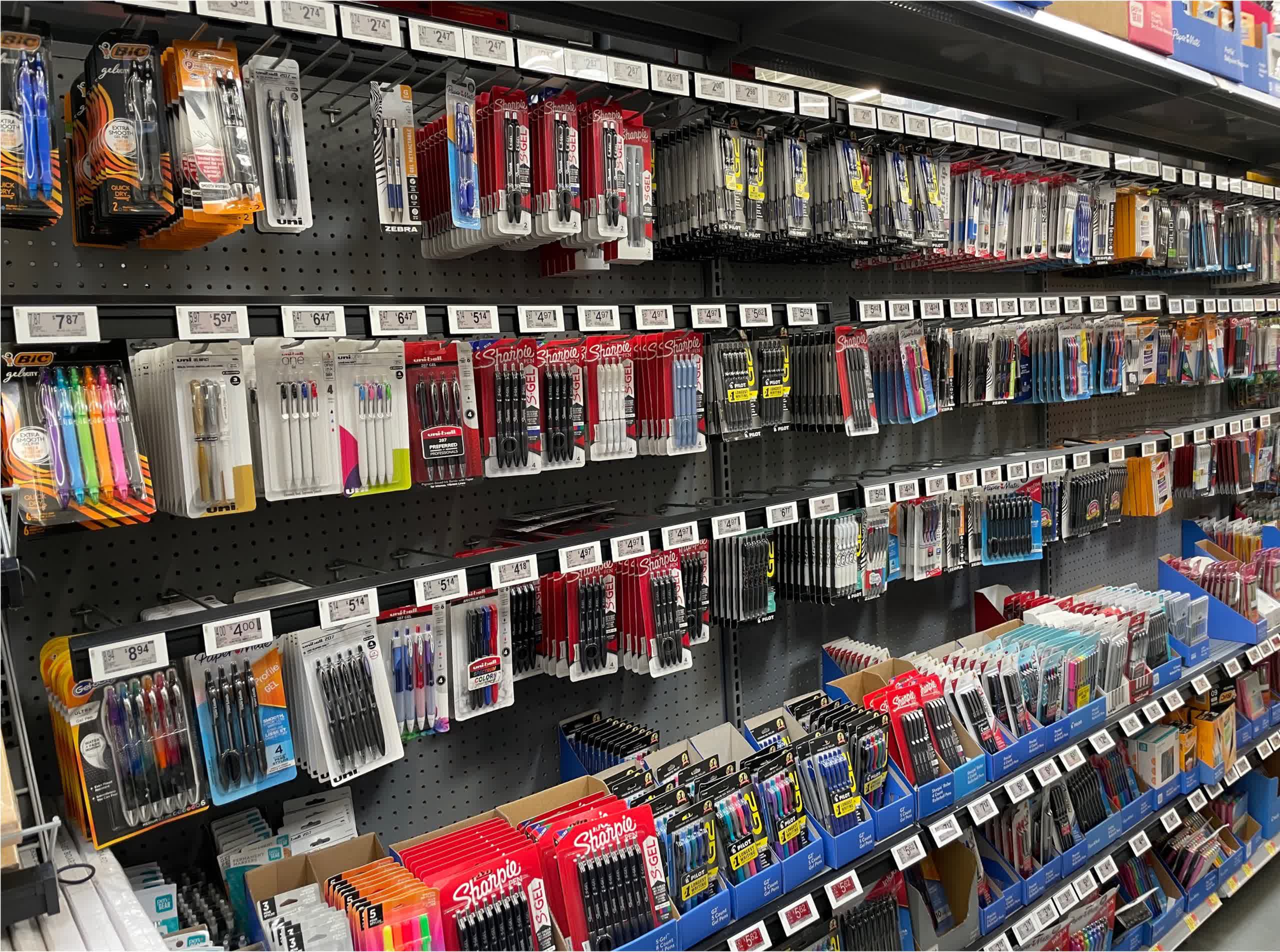It’s bound to happen. Why waste hours replacing tags when you can just change what the shelf says when the prices change.
But this article is so pro Walmart it’s crazy.
Retailers argue that these innovations increase efficiency and reduce costs in an industry known for its slim profit margins.
Slim profit margins my ass. Walmarts gross profit for the twelve months ending July 31, 2024 was $163.786B,
I think the main concern is that this is a step towards normalizing extremely frequent price changes, a la Uber surge pricing.
That’s exactly what this is. All stores will eventually do this and prices will fluctuate throughout the day.
Paper ticket stores already do this, its just a more work for the workers than e-ink.
And personalized pricing, based on your profile and what they think they can get you to pay.
I can’t wait for them to get sued into the ground because their AI is changing prices based on skin color.
Well, that’s what coupons are for.
So, if I grab an item off the shelf and browse around the store for a while, is the price going to be the price currently displayed or the price when I grabbed it?
If it’s the current price, what’s the point of a price tag? If I can’t actually know the price until checkout, then showing me the price is kind of a useless bit of data. I also suspect that the “speak to a manager” types would make that a major headache for stores.
If it’s the price when I grabbed it, how are they keeping track of that? I see two ways of handling that: one requires that you use their app to shop, and the other requires cameras and “machine vision” that are still unreliable, at best. The former seems more likely, but I doubt either is going to sit well with customers.
Edit: someone pointed out that it might not actually display a price, and you’d have to scan it to get your price. Kind of like the first option, but I think it’s going to turn off less tech savvy customers.
I haven’t seen that aspect addressed in any articles about the “feature”.
Take a photo of it, I work with paper but we change our tags frequently. We often have prices changed when a customer reaches checkout. I’ve also had times where a customer came back to check a shelf tag after I just updated it. I honored the previous price those times as I was still holding the tickets but its not a guarantee even in paper stores.
We often have prices changed when a customer reaches checkout.
I know this isn’t your fault or anything but damn, that seems lightly customer hostile at best, and deeply unethical at worst. It sounds like it should be illegal.
I can’t speak internationally or legally but from what I know from friends in similar jobs daily prices changes aren’t uncommon. The reason and when it happens often is normally the start of the day when there is a new batch of tickets. They don’t go up instantly and multiple 100s of tickets normally take a couple hours to get placed depending on how many/busy staff are.
Main thing is e-ink’s don’t really make this significantly better or worse. I personally think they are neat for the end worker. The problem is that this is allowed or not enforced well.
Even at stores that have this feature, I rarely see people use it. It’s clearly not an experience that people flock to.
OTOH, on the rare occasion I’ve visited a Walmart in the past 10 years, I have a 100% rate of checkout taking an absurdly long time. Everyone there just seems to accept it like they have no choice.
It will become an Olympic event where you have to get from the shelf to the till before the price changes!
I edited in another thought. I agree with that fear, that’s obviously the concern. I didn’t feel the need to repeat it.
Slim profit margins my ass. Walmarts gross profit for the twelve months ending July 31, 2024 was $163.786B,
Walmart has 10.5k locations. 163B divided by 10.5K is about $15.6M per location.
Jesus, in what world is $15M profits per store location considered a “slim margin”?
Slim profit margins my ass. Walmarts gross profit for the twelve months ending July 31, 2024 was $163.786B,
Not to sound flippant, but do you know what gross profit means? They aren’t pocketing all of that. Walmart’s net profit margin is 2.66%, which is minuscule. They make up for that by having enormous volume.
That’s an expected tradeoff of operating an essential service is the point. It’s not as though their margin is that slim by mistake, or out of goodwill, or bad business sense. It’s meant to lead to the situation where we shop at Walmart not by choice, but in lieu of other options.
Not really — it’s because nearly everything they sell is highly fungible, and they compete on price. Nobody is willing to pay a premium to shop at Walmart. Twenty years ago you’d have been correct, but they’ve pretty much saturated the market at this point. They’re trying to find profitability in automation rather than adding tons of new stores.
I’m really meaning the lack of option not to consume fast-moving consumer goods, rather than the option to pay a premium for them elsewhere. When their market position is similar to like an outlet for government rations except for private profit, their net is essentially what was skimmed off the top of free enterprise. 2.66% is just the current maximum amount that is justifiably worth without doing societal harm
That’s true, but what you describe is pretty much the end state of big-box retail. Amazon is essentially the same, if we exclude AWS. It’s all a race to the bottom. The solution, as always, is to buy direct from smaller producers if possible.
You made a good point and I immediately thought that reporting a gross profit dollar amount as an example of how profit margins are not slim as simply inappropriate. And I would have responded myself if you hadn’t. There’s no single dollar figure that can inform anyone about anything useful about the profit margin of a business. A number without context is useless.
Gross profit can be defined as the profit a company makes after deducting the variable costs directly associated with making and selling its products or providing its services.
Flippant away
Yes, but there are many more expenses associated with running their business beyond simply COGS. Their net income last year was 11B, which is pretty average for a company that size.
I’ll be completely honest. I don’t care anywhere near enough about the actual number that you do. I looked it up, and that was that. I didn’t write a financial report.
I dislike that you’ve put me in the position of defending Walmart, but don’t you find it rather misleading to imply that they made 163 billion dollars in profit when the real number is less than 10% of that?
Have a good one
Work in retail without e-ink and a lot of the concerns people have here already happen with paper. We do full store paper price tag updates daily, also someone will go around with a scanner making sure prices are up to date with website and print new sheets if not.
Normal days will consist of 3-5 new batches of tickets with the full store update batch containing normally ~10-20 a4 sheets. This isn’t a huge store either I imagine most wallmarts would have more products.
The prices already update super frequently and e-inks don’t really change that. It basically just cuts out the printing and placing, the person running around with the scanner now updates prices.
I think for workers they are nice as they reduce the chance of paper cuts and the back and leg pain from changing the 100s of bottom shelf tags.
The benefit for stores is they likely don’t need to hire as many people, less training and possibly reduced material cost over time as the paper would probably add up.
I’m not worried about e-ink price tags. Aldi has them. I’m worry if it says, use your phone to find special offers only for you.
Rightfully worried IMO
Haven’t digital price tags been used for decades? I’m sure these will be more high tech, but I remember ones like this at least 20 years ago
Yeah these have existed for a while.
I think the only thing new is that walmart previously talked about actually implementing “on demand pricing” and now that they’re adding digital price tags they could actually do it.
I think this will be potentially be a good thing (at first) as you won’t have people wasting their life away just endlessly walking around the store updating the price of every individual item for 40 hours a week.
Things will get messy when they start price gouging based on current inventory, weather, holidays or emergency situations.
Things will get deeply dystopian if they start scanning customers as they enter and change the price based on their skin color, gender, clothing, or estimated net worth.
or estimated net worth
Walmart credit card. They don’t need to estimate when you willingly provide it.
It’s not just Walmart - the entire grocery sector is doing it. The potential for abuse is certainly not low.
The new labels allow employees to change prices as often as every ten seconds. - NPR
It would be a crying shame if someone were to figure out a way to force those e ink displays to refresh fast enough that it kills the batteries on those things…
Obviously the way to combat this is to organize dozens or more people who just walk around, load up shopping carts, then leave the store without buying anything. They can pay people to put everything back.
As long as they are still sending out flyers with stuff you buy you are okay. Also, if you already knew the price range of your regularly shopped goods, you know something is off. Superstore is already using digital tags. And you can just pull out your phone and take pictures.
Lastly, it should be put into law so you can’t increase price during the day. Going down is fine, but no going down and then going up again for peak hour. Stores can set whatever price they want to sell before opening. (for those non-regulated things)
New Jersey has a law like that for gas. Can only increase the price one time per day. But ut doesn’t apply to all gass stations, just ones on the highway rest areas.
Those have existed here for a long time and we got none of those problems.
Yet. Infrastructure on this scale moves slowly and the transparentness of pricing changes on short time lines in physical stores is hard to track. It exists in emergency economies - we call it price gouging - but that’s usually quite obvious. The idea of dynamic pricing has existed forever - hotels, airline flights, movie tickets, taxi rides, even electric rates. As technology advances it offers the opportunity to use the technology to shorten the time window for pricing changes more and more. An extra two tenths of a percent profit seems like a trivial amount. Amazon and Walmart combined for more than a trillion dollars in sales last year. 0.2% is a very non-trivial $2 Billion. If it becomes available, it will be exploited.






